In the world of living history, the clothes make the man (and woman).
Enlarge
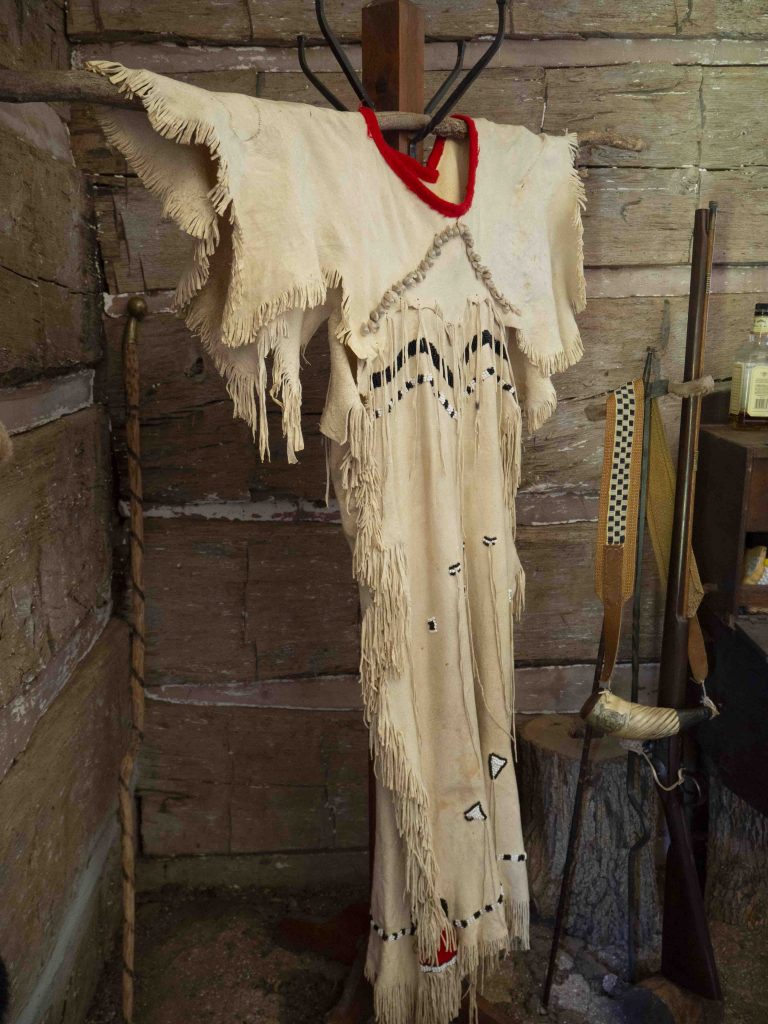
Story by Renae Blum
The cannon smoke has mostly dispersed, visitors are trickling back to the parking lot, and Sarah Dack is taking a break.
She portrays an officer’s wife at Fort Kearny State Historical Park’s living history events, and looks every inch the part. Dack is wearing a big-brimmed sunbonnet, leather ankle boots, a sky-blue skirt, and a muslin shirt with pearl buttons, a stand-up collar, and a gathered yoke. Her accessories include an engraved pocket watch necklace and small dangling earrings.
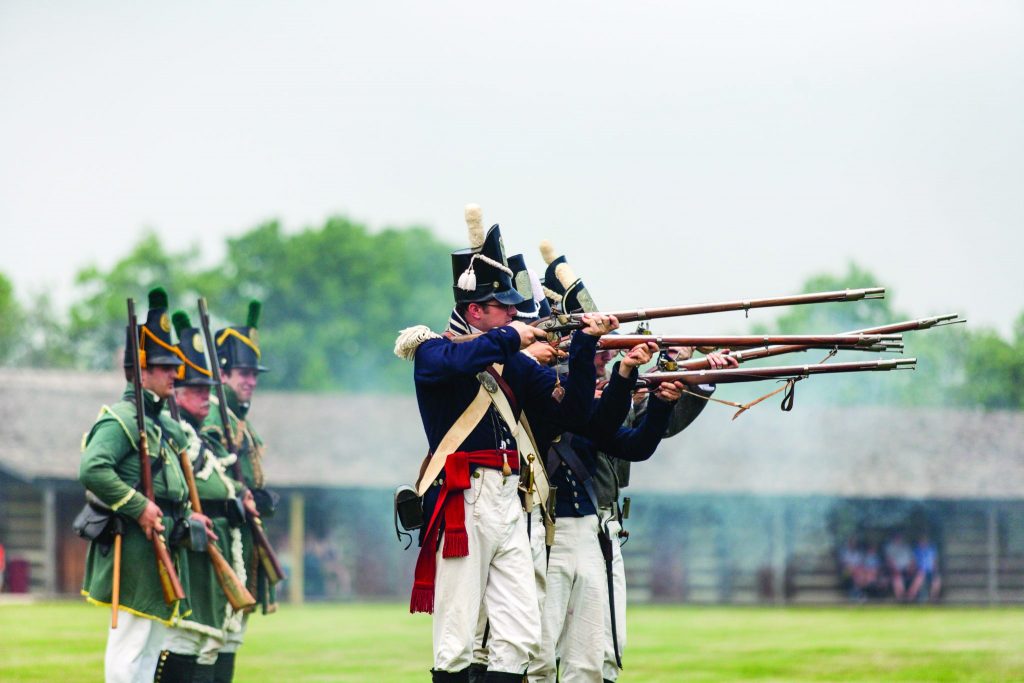
At a living history event like this one, it’s a common sight – men, women and children walking around dressed in beautiful period clothing, looking as if they’ve stepped out of a history textbook. But putting that look together isn’t so simple.
“You don’t go to Walmart to buy anything; everything is handmade, and it follows a pattern or some historical piece,” said Betty Hruska of Firth, Nebraska.
There’s also the challenge of being historically accurate. “In a way, we are educating the public. You’re trying to portray an accurate look,” said Heather Blazicevich of Omaha. “We want people to feel like, ‘My time spent here was good because people really care about historical accuracy.’”
When it comes to finding that perfect outfit, you’ve got a few options. If you’re intimidated by a sewing machine, you can purchase an outfit from a period supplier. And fellow volunteers are often happy to help, offering to make you something or provide clothing for trade or lending. But for the pride of ownership and sheer cost effectiveness, sewing your own period clothing is, for many people, the way to go.
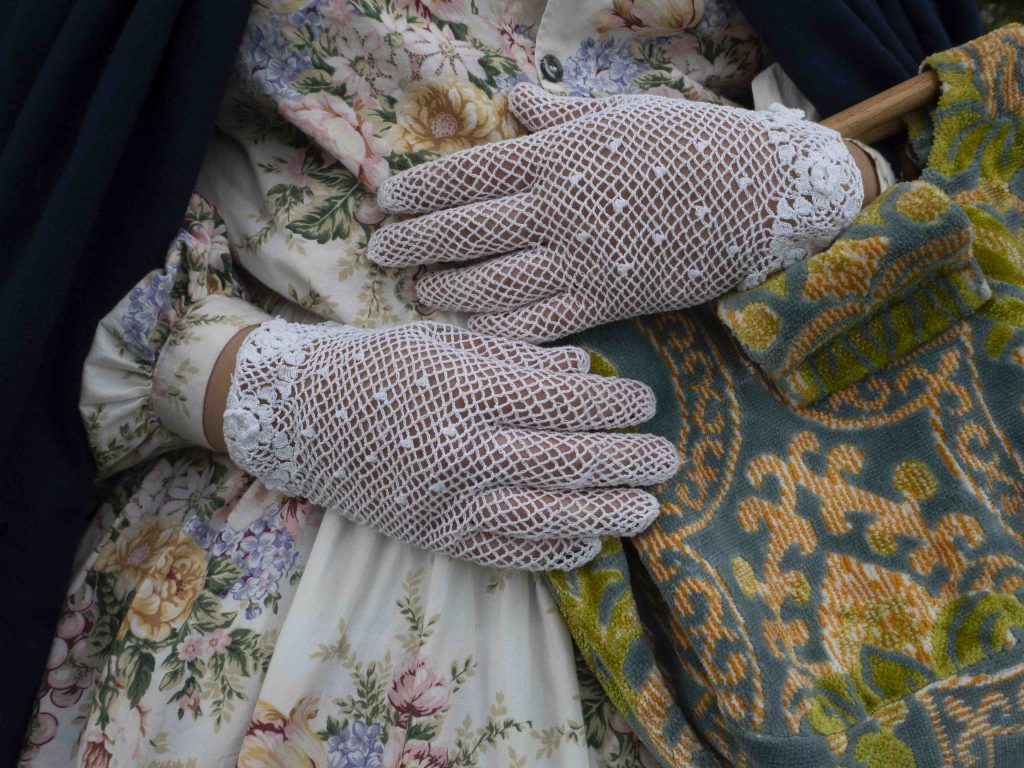
For some, this is a struggle. For others with a little more experience, it’s an art form, and even a money-making venture. Tom Wood of Omaha, who participated in living history at Fort Atkinson State Historical Park for more than 40 years, sells pieces professionally to buyers around the world, and has even made clothing for a period wedding.
“It takes a long time to learn certain curves and stuff like that, or what gives it shape,” Wood said. “Once you figure that stuff out, it’s easy to make patterns for it.”
Then there is someone like Andrew Gaghagen, who’d done some basic mending but had never sewn an outfit before joining Fort Atkinson’s living history program in early 2018.
Gaghagen jumped in headfirst, buying a sewing machine and throwing himself into online research. He ordered the wool for his soldier’s jacket from a period supplier in Missouri, and ended up selling the first batch he received – the weight of the fabric was incorrect, and the shade of gray was too brown.
“I kind of feel a sense of duty to get it as historically accurate as possible, because [Fort Atkinson] is there for education. So cutting corners like that wasn’t something I wanted to do,” he said. “If I had that information I was going to make it as close to how it would have been as possible.”

It took multiple frustrating tries to make something he was satisfied with. But now, with one season of living history successfully under his belt, Gaghagen has begun making clothing for other volunteers.
Some reenactors put their own research behind their clothing, studying old paintings, visiting museums, checking out library books, even taking notes from movies like “Pride and Prejudice.” And thanks to the Internet, resources are just a click away, and more extensive than ever before.
After a certain point, you develop an eye for period accuracy. Fort Kearny State Historical Park volunteer Renae Hunt can watch a historical drama and spot inaccuracies in the clothing; Blazicevich can do the same thing with patterns. As she’s discovered, some patterns made by mainstream companies can look vaguely historical, but turn out to be riddled with inaccuracies once you take a closer look.
Most volunteers at Fort Atkinson choose clothing patterns made by companies that specialize in historical accuracy, said Denise Wenke of Omaha. Some companies “have actually gone into museums and gotten a chance to get hands-on and take measurements and see where the curves are, which way the seams run,” she said. “It’s a much better option for me.”
Sewing period clothing is very different from sewing modern garments, Wenke said. At first glance, the whole set-up can be a bit bewildering, even for an experienced seamstress.
“A lot of the seams aren’t placed where they are in modern garments, necessarily. There are a lot of curved seams. And the pattern pieces just do not look like what you’re used to pattern pieces looking like,” she said. “They just had a very different idea of how to cover the human body.”
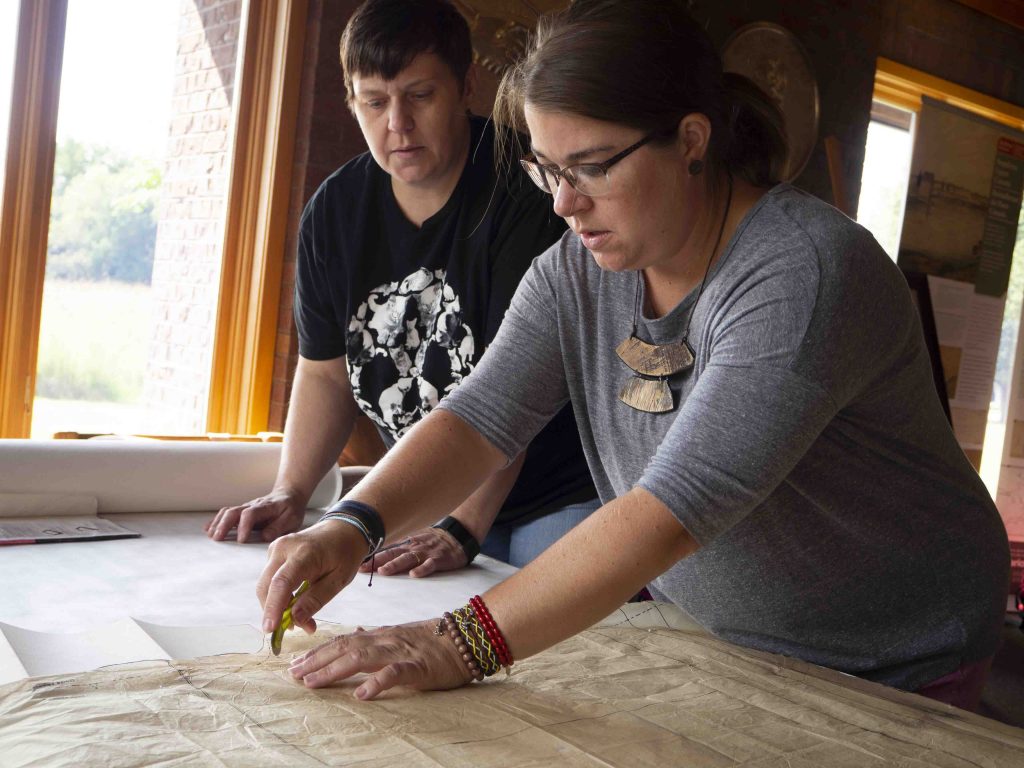
After researching, creating and wearing period garments, volunteers often gain a unique perspective into the lives and culture of the people they portray. For soldiers at Fort Atkinson, standing up straight and tall was an important part of their image as military men – something living history volunteers learn as they contend with period-accurate uniforms so tight-fitting they’re unable to slouch.
And for Wenke, a volunteer at Fort Atkinson, hand-sewing period clothing gave her insight into the rise of the sewing machine. “After making something by hand you can appreciate why people had fewer changes of clothes in this time period, and why, as soon as the sewing machine was invented, even though the price was sky-high, they were in such demand that communities would band together to buy one.”
Dressing for an 1820s Fort
Like many living history volunteers in Nebraska, the reenactors at Fort Atkinson State Historical Park take seriously their duty of educating the public, and the attention to detail shines through in their clothing. Many pieces are handmade, and some are custom-ordered. Pictured are (left to right) Kristy Ericson of Omaha, dressed as a laundress, and her daughters Taylor and Lylah. Bob Baker of Omaha portrays the captain of the rifle regiment. Baker’s entire ensemble cost around $2,000, which is typical for someone portraying a soldier. For him, the cost is worth it. “I get to share my cost with lots of people and get a great deal of satisfaction and enjoyment in the process,” he said.
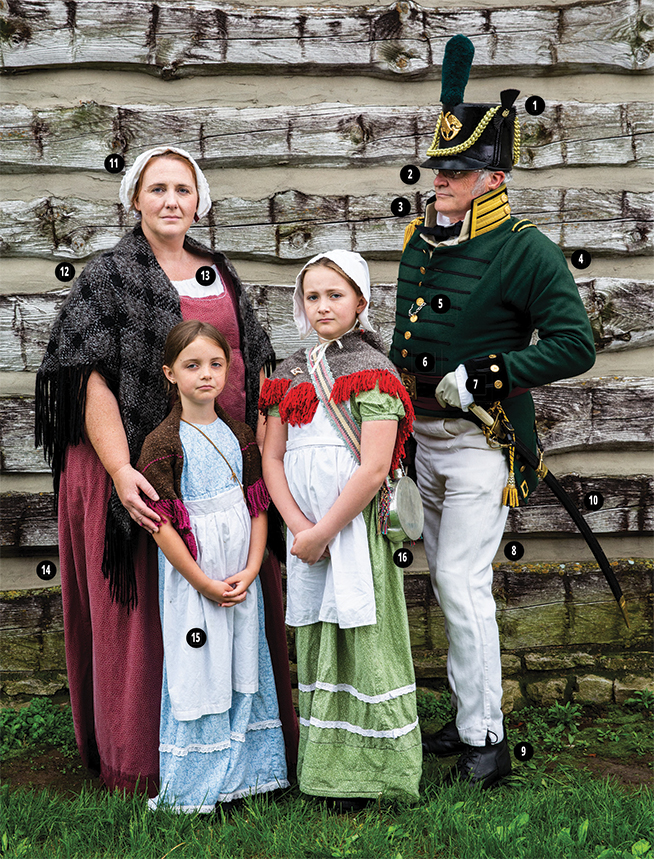
1. Shako
A shako was a leather cap worn by enlisted men. The color of the wool pom sticking up from the top signified that the wearer belonged to the rifle regiment. The cap plate – the brass insignia on the front – is a copy of an original found on the site of Fort Atkinson, and shows an eagle carrying a rifleman’s horn.
2. Eyeglasses
The prescription reading glasses Baker is wearing are copies of an original that dates back to about 1790. “The lenses in these do have a bifocal, which is not something that was made back then,” he said.
3. Undershirt and bowtie
Along with a wool vest, beneath the coat Baker is wearing is a
long white cotton undershirt. “They didn’t really have what we refer to as underwear,” Baker said; the long undershirt was worn instead. The bowtie is “a
nod toward civilian fashion,” Baker said, and also an homage
to the neckstock, a piece of leather worn by lower-ranking soldiers that kept them from looking down at their feet.
4. Coat
This 1812-period wool coat is something an officer would have worn in a social setting. “It was something so ostentatious that it would draw attention. And as an officer that’s what you would want to do in social situations,” Baker said. “You couldn’t brag about your rank, but you could certainly wear something that looks like you could afford it.”
5. Buttons
Baker has a pewter casting operation and makes the buttons the soldiers wear. The design is based off of buttons uncovered by archaeological digs at Fort Atkinson.
6. Officer’s Sash
Sashes indicated rank and were used to wrap injured soldiers in and carry them off the battlefield. They were dyed scarlet/burgundy to blend in with any arterial blood that was shed. The fear was that if nearby soldiers saw how badly wounded an officer was, they would become demoralized and run away, rather than continue fighting.
7. Gloves
Gloves were typically worn by officers mostly in ceremonial situations, just as they are today, and were made of calfskin or goatskin. Baker got his from a period supplier.
8. Trousers
Baker is wearing narrow-fall drop front trousers. They are made of hemp, a flexible, durable fabric similar to denim.
9. Shoes
Baker’s shoes are “almost a boot,” he says, “what we call a three-quarter height shoe.” This height allowed more freedom for someone on foot, as a company captain likely would have been. Baker had his pair custom-made at Omaha’s Dehner Boot Company for about $400.
10. Sword
An officer’s sword was more ceremonial and not necessarily used in battle. An officer on horseback was more likely to carry a curved sword, or saber, to avoid cutting the neck of his horse with his sword when drawing it. This replica was made in Pakistan and cost Baker $175.
11. Cap
The working-class women and girls of Fort Atkinson would typically have their heads covered while outside to protect themselves from the sun and any debris and insects. Kristy’s head covering is called a country cap, and Lylah’s is a colonial cap. Kristy sewed both using period patterns.
12. Shawl
The wool shawls pictured here were handmade by the Ericson family, woven on a triangle loom. They used wool from Columbia sheep that Kristy’s mother-in-law raises.
13. Chemise
Like the men’s undershirt, the chemise was a long, loose undergarment that doubled as sleepwear.
14. Dress
The fashion of the day was the Empire waistline, falling just below the bust. Drawstrings at the neck and bust made it easy to dress yourself. Work dresses are made of cotton and feature earthy, natural tones and a repeating pattern, which would have been easy to manufacture at the time.
15. Apron
Aprons were worn quite frequently to protect clothing. They can have other uses, too, for a living history volunteer: “I use mine as a hot pad some days,” Kristy said. “Just super convenient.”
16. Canteen
This tin canteen was made by Chris Hagemann, who portrays a tinsmith at Fort Atkinson and taught himself how to master the craft. Hagemann’s workmanship can be seen throughout the Fort. Lylah wove the canteen’s strap on a rigid heddle loom at the fort.
While it’s possible to make a living history outfit inexpensively, some volunteers take it up a notch, investing in custom-made shoes, specially tailored soldier’s uniforms, period-style prescription eyeglasses, period-accurate weaponry, and more. It quickly adds up. People portraying soldiers can easily spend $2,000 or more on a full kit.
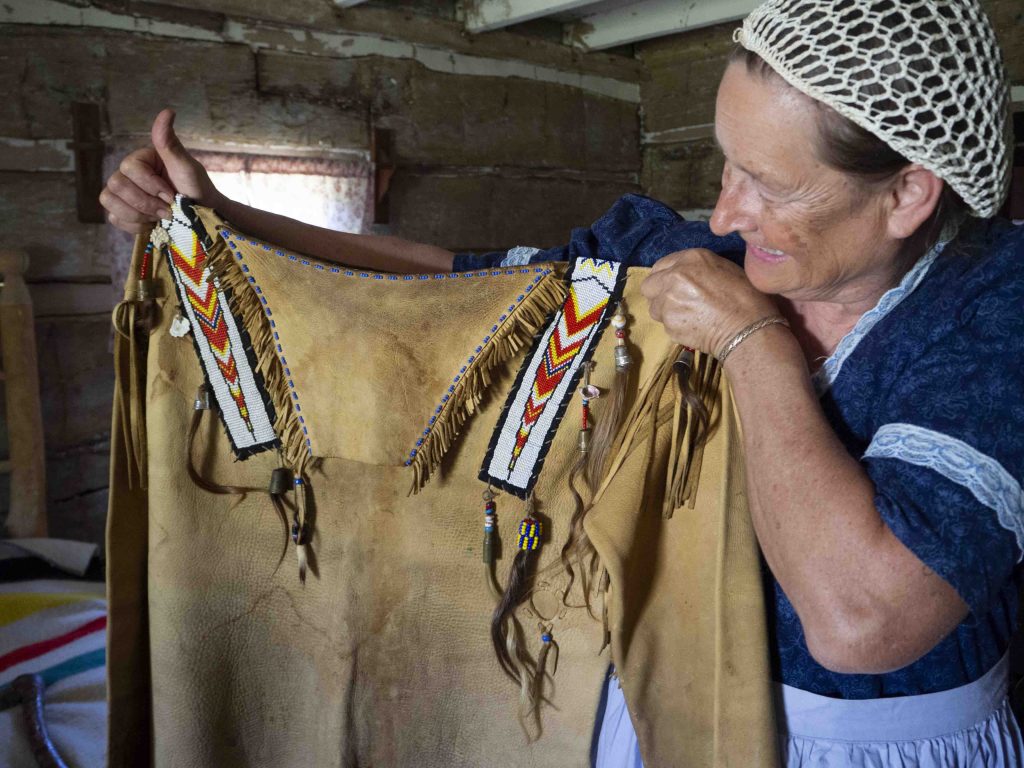
In the end, putting on a handmade, period-accurate outfit can be a special experience, and it does something valuable for the person wearing it, too, not just the visitors looking at him or her.
“Putting that outfit on runs you right back in time,” said Wade Davis of Bonner Springs, Kansas, who portrays an Indian trader and interpreter at Fort Atkinson. “It helps transport you back to the time and place, kind of like an actor preparing for a role.”
And when the image is complete, the results are pretty unforgettable. ■
Living history events are held at the following Nebraska state historical parks: Fort Atkinson, Rock Creek Station, Fort Hartsuff, Buffalo Bill Ranch, Fort Kearny and Arbor Lodge. Indian Cave State Park occasionally holds events as well. For more information, visit Calendar.OutdoorNebraska.gov or contact individual parks.
The post A Stitch in Time appeared first on Nebraskaland Magazine.
















